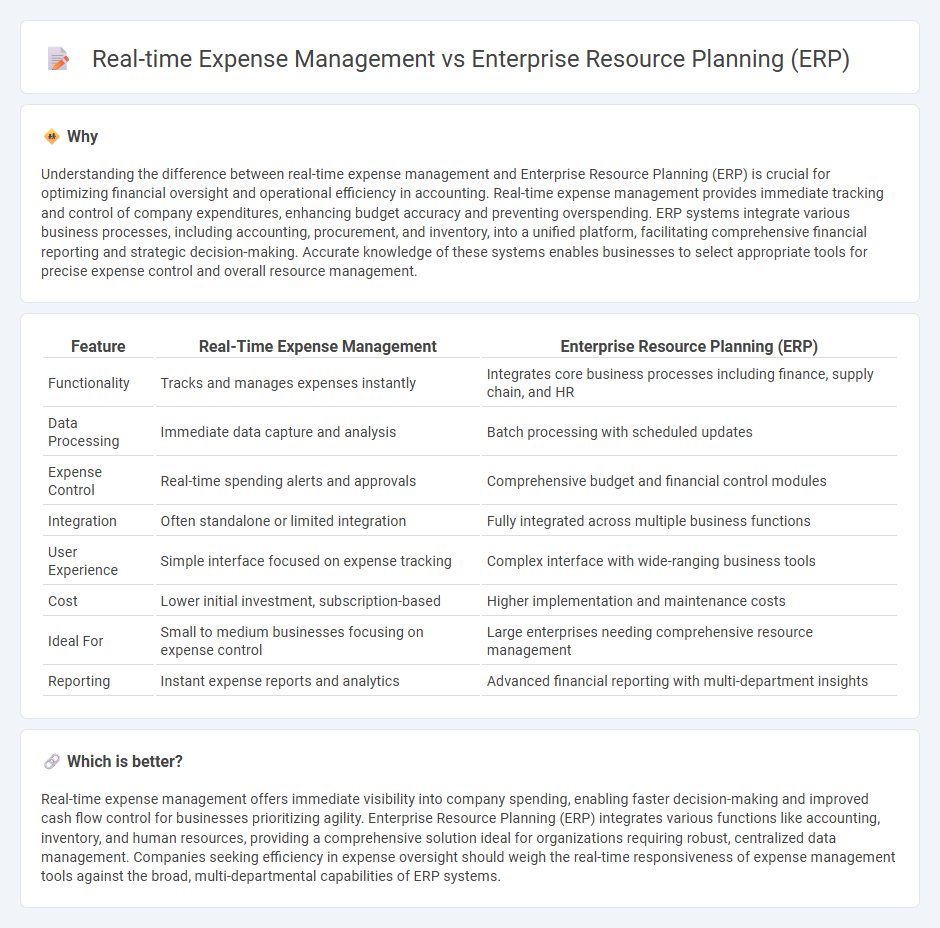
Real-time expense management systems enable businesses to monitor and control expenditures instantly, improving cash flow accuracy and reducing financial discrepancies. Enterprise Resource Planning (ERP) integrates various business processes, including finance, supply chain, and human resources, offering a comprehensive overview for strategic decision-making. Explore how these technologies transform accounting practices and optimize financial operations.
Why it is important
Understanding the difference between real-time expense management and Enterprise Resource Planning (ERP) is crucial for optimizing financial oversight and operational efficiency in accounting. Real-time expense management provides immediate tracking and control of company expenditures, enhancing budget accuracy and preventing overspending. ERP systems integrate various business processes, including accounting, procurement, and inventory, into a unified platform, facilitating comprehensive financial reporting and strategic decision-making. Accurate knowledge of these systems enables businesses to select appropriate tools for precise expense control and overall resource management.
Comparison Table
| Feature | Real-Time Expense Management | Enterprise Resource Planning (ERP) |
|---|---|---|
| Functionality | Tracks and manages expenses instantly | Integrates core business processes including finance, supply chain, and HR |
| Data Processing | Immediate data capture and analysis | Batch processing with scheduled updates |
| Expense Control | Real-time spending alerts and approvals | Comprehensive budget and financial control modules |
| Integration | Often standalone or limited integration | Fully integrated across multiple business functions |
| User Experience | Simple interface focused on expense tracking | Complex interface with wide-ranging business tools |
| Cost | Lower initial investment, subscription-based | Higher implementation and maintenance costs |
| Ideal For | Small to medium businesses focusing on expense control | Large enterprises needing comprehensive resource management |
| Reporting | Instant expense reports and analytics | Advanced financial reporting with multi-department insights |
Which is better?
Real-time expense management offers immediate visibility into company spending, enabling faster decision-making and improved cash flow control for businesses prioritizing agility. Enterprise Resource Planning (ERP) integrates various functions like accounting, inventory, and human resources, providing a comprehensive solution ideal for organizations requiring robust, centralized data management. Companies seeking efficiency in expense oversight should weigh the real-time responsiveness of expense management tools against the broad, multi-departmental capabilities of ERP systems.
Connection
Real-time expense management integrates seamlessly with Enterprise Resource Planning (ERP) systems by providing instantaneous tracking and reporting of financial transactions, which enhances the accuracy of budgeting and forecasting. ERP platforms consolidate expense data across departments, enabling synchronized financial control and improved cash flow management. This connection optimizes accounting processes by reducing manual errors and accelerating decision-making through up-to-date expense visibility.
Key Terms
Integration
Enterprise resource planning (ERP) systems offer comprehensive integration across various business functions including finance, supply chain, and HR, ensuring seamless data flow and centralized management. Real-time expense management solutions focus on instant capture and approval of expenses, often integrating with ERP platforms to enhance financial accuracy and reporting capabilities. Explore our detailed analysis to understand how integrating ERP with real-time expense tools can optimize your business operations.
Automation
Enterprise Resource Planning (ERP) systems integrate automation across financial, human resources, and supply chain management, enhancing data accuracy and operational efficiency. Real-time expense management platforms specifically automate expense tracking, approval workflows, and reimbursement processes with instantaneous data updates and compliance checks. Explore how automation transforms financial operations and boosts productivity by understanding their unique capabilities and applications.
Data synchronization
Enterprise resource planning (ERP) systems consolidate data across finance, supply chain, and operations to ensure consistent updates and accurate reporting, while real-time expense management platforms provide instant data synchronization on employee spending and approvals to enhance budget control. ERP uses batch processing for periodic updates, whereas real-time expense tools employ continuous data flows for immediate visibility into expenses. Explore how integrating both can streamline financial processes and improve organizational agility.
Source and External Links
Enterprise resource planning - Wikipedia - ERP is an integrated management system that leverages software and technology to manage business processes, often in real-time.
What is Enterprise Resource Planning (ERP)? - IBM - ERP software integrates various business functions like finance, HR, and manufacturing, using a common database to streamline operations.
What is ERP? A Comprehensive Guide - NetSuite - ERP systems automate business processes and provide insights by centralizing data from multiple departments, enhancing efficiency and productivity.
 dowidth.com
dowidth.com